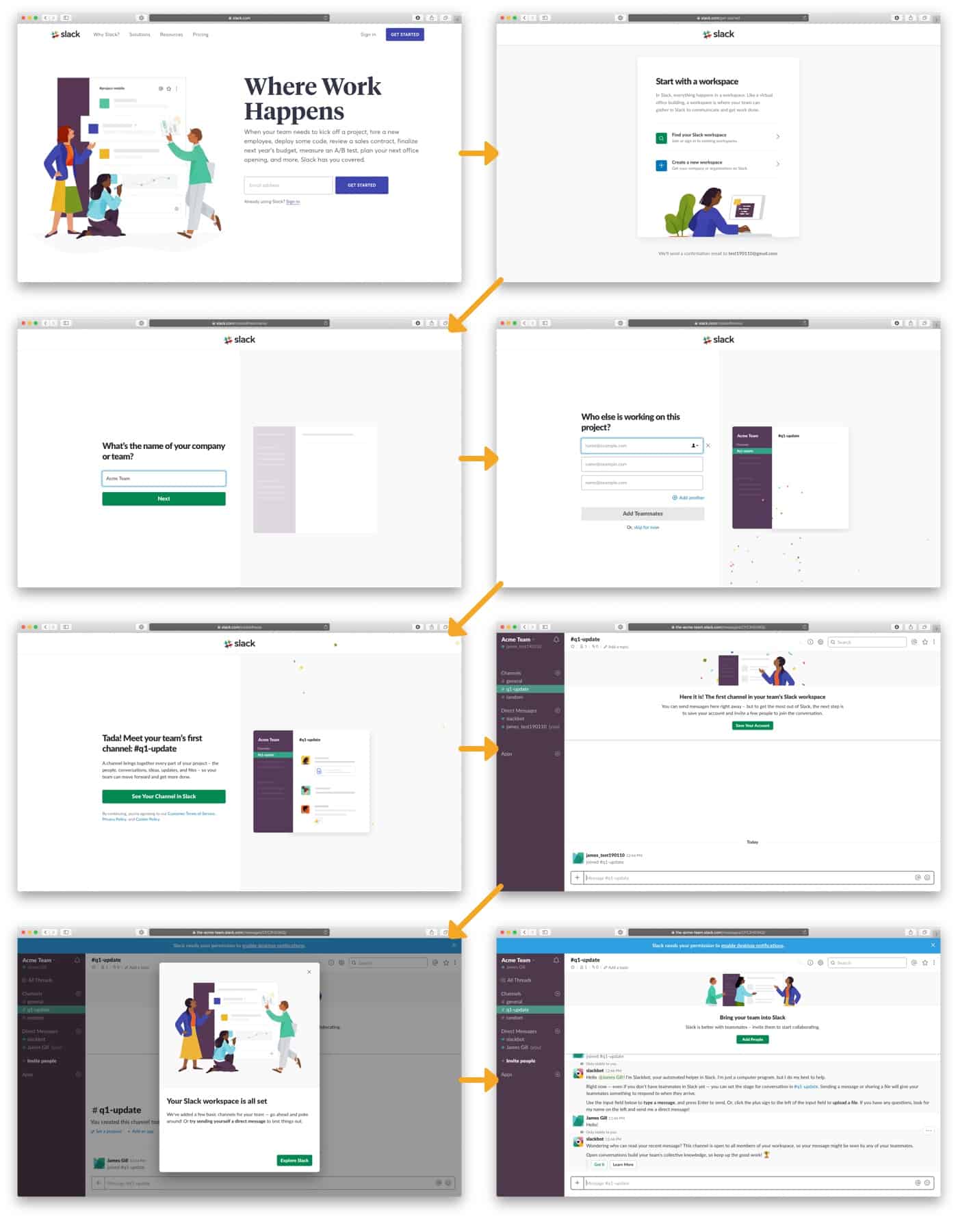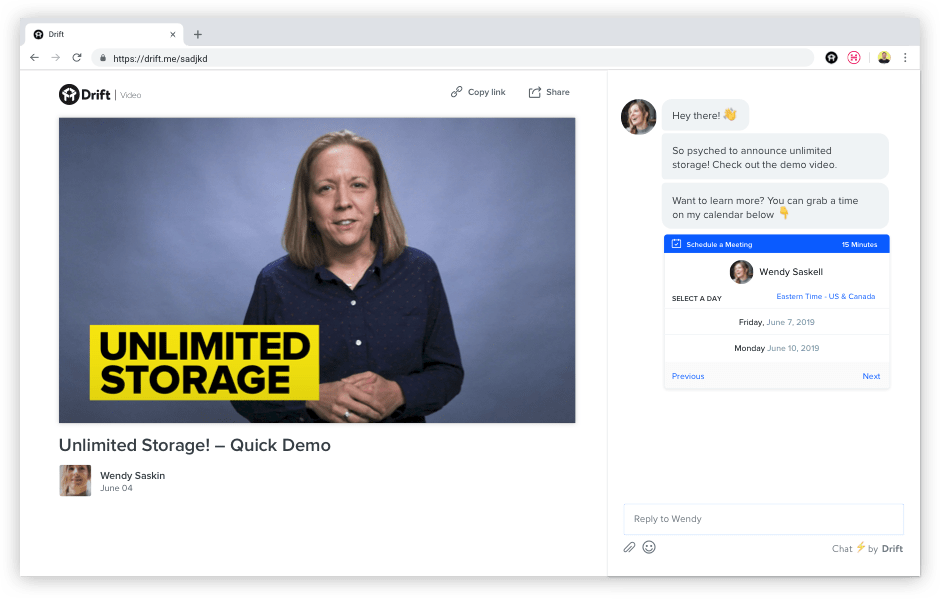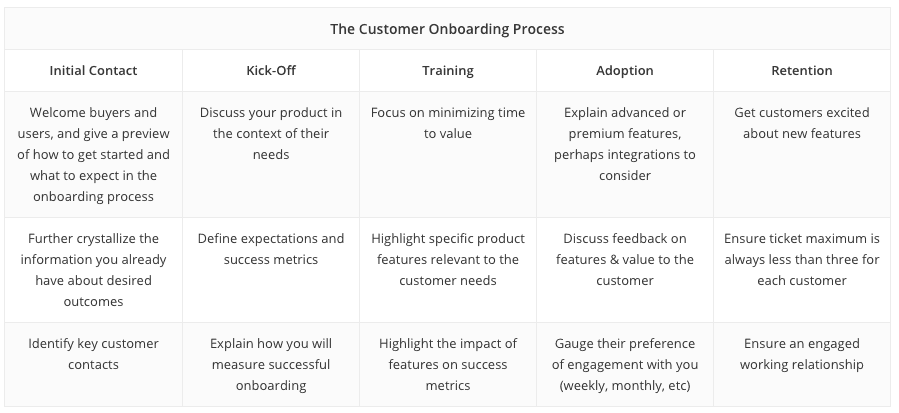
Customer onboarding is the process of guiding a new customer through the key features of your product.
It’s important to understand that customer onboarding isn’t just a poorly produced ‘welcome to the team’ marketing video. It’s all about giving the customer the tools they need to make the most out of your product or service.
This process sets the stage for your relationship with customers moving forward—proving that you’ll follow through on what was offered in the sales pitch and that you’re there to help them reach their goals.
Why is Customer Onboarding Important?
Today, many companies offer free trials or freemium plans to get users to give their product/service a try. The issue there is, customers may be less likely to fully adopt the solution after the purchase.
Instead, it’s worth looking at your customer journey as something that begins during the consideration or decision phase of the sales funnel not up top at the awareness stage. If done right, customer onboarding can reduce churn by improving customer satisfaction—and from there, increase revenue.
For employees, a well-executed customer onboarding improves their customer experience, as well by making interactions more productive and less stressful. The reason is—A, customers gain a clear understanding of how the product works and know that help is a call or a click away. And B—the company has started the relationship on a positive note. The first impression doesn’t take place when say, an angry customer calls to complain about an issue.
If that’s not enough to sell you on the whole onboarding thing, here are a few stats that can back us up on this one.
- 75% of users drop off within the first week
- More than two-thirds of SaaS companies have churn rates greater than 5%
- Studies have found that around 55% of customers are willing to pay more for a guaranteed good experience
- Somewhere between 40-60% of free trial users will try your product once and never come back
What Should a Customer Onboarding Process Look Like?
Like any campaign, a customer onboarding process should begin with a well-planned strategy. Start with a handful of goals and from there come up with a plan of attack. Of course, you’ll refine this as you learn more about your customers, but you have to start with an objective in mind.
This chart offers a nice breakdown of how you might go about piecing together your customer onboarding process.
Of course, these ideas are pretty broad. What you’ll need to do to find your ideal onboarding process is to figure out what success looks like for your audience.
- What is the customer’s ideal outcome?
- How do they measure success–individually and as an organization?
- What are their goals?
- What do they hope to achieve by using your product?
Answering these questions will help you determine your user onboarding flow.
In this example from Slack, they’ve identified a sequence for getting from Screen A to B, to the final stop.
As you map this process out, consider how many screens or sessions you’ll want to include. Where do you see this process beginning? What is the endpoint? What features and processes will you need to cover?
User Onboarding Best Practices
A few things to think about as you put together your customer onboarding strategy.
Use Your First Interaction to Create a Personalized Onboarding Checklist
Every client you deal with is going to be different. As such, it’s important to go into each onboarding process with a custom approach.
Treat this meeting (or call) as an information gathering session where you assess how well the client understands what you’re offering. You’ll find that some clients are quite knowledgeable, whereas others will need foundational training to get going.
After gathering information, create a custom checklist for your customer that goes over what they can expect to learn and over what time frame.
Get Visual
We all learn in different ways. Make it easier on your customers by creating interactive walkthroughs, combining video explanations with an inside view of your tool, rather than expecting customers to grasp new concepts through a dense e-book with no images.
Make Onboarding a Personal Experience
Every customer has their own set of challenges and goals. You’ll want to make sure your solution addresses needs on a personal level—this might mean creating custom onboarding packages for each customer type, or perhaps, in an ABM context, a custom onboarding experience for each customer.
Be There for Support
Make sure customers know how they can get in touch if needed. Consider adding a direct-to-chat link in every email and provide multiple ways to get in touch.
Customers want to feel like you’re not just dropping them into new territory to fend for themselves—let them know if they get stuck, there’s always a way to get help.
Bring Onboarding Software into the Mix
It’s 2019, so it’s safe to say that any customer onboarding strategy is made easier and better with the right technology standing behind it. Drift video can be a great way to offer customers short tutorials and personalized demos.

Tools like your CRM and marketing automation platforms can help you keep tabs on who has gone through the onboarding process and over time, help you track the impact of your efforts.
Don’t Overwhelm Your Customer
One of the most important things to think about is that you want to avoid presenting too much information at once.
Break training sessions into shorter blocks that cover one or two topics at a time. Avoid creating long documents of reading material that your customers need to spend time sorting through just to get going with the tool.
Get Customers to Hit that First Success
Finally, one of the most important things to understand about customer onboarding is the faster you can really “wow” the user with your product, the better.
Once your solution helps them reach a goal, there’s a good chance that they’ll see the value and become a loyal customer long term. Even better, this lays the groundwork for further upgrades and cross-sells down the line.
The Impact That Customer Onboarding Has on Retention Rates
When looking at churn, there are a few reasons why someone drops out of the system, so to speak.
- They no longer need this item
- They’ve found something they like better
- Your product fails to meet expectations
- The customer doesn’t understand how to use the product
In many cases, the last two items happen when you don’t provide a proper user onboarding experience. Long-term retention is closely linked to what happens during this early stage, and often, you can predict how long a customer will stick around based on the actions they take or don’t during their first week as customers.
Some companies, unfortunately, will send an email with login credentials and that’s that. Obviously, this approach won’t work. You’ll need to guide your users through how to get started and prove your value right off the bat.
5-Point Checklist for Customer/User Onboarding
We looked at some of the benefits and best practices associated with spending some time creating an onboarding program.
Here, we’ve created a five-point checklist for setting up your end-to-end onboarding process. This should help you break down the “why” behind each piece of the strategy, ensuring that you stay on track, adding value at each stage.
Step 1: Establish the primary goal for your onboarding program.
What is the most important thing you want customers to walk away with? The primary goal should be that “first success” we mentioned in the main article. Basically, what can you do to get your customer to the point of a first win, as quickly as possible?
Step 2: Establish secondary goals or milestones.
These secondary goals represent what happens after the first AHA! moment. What keeps customers on the hook for the long haul?
Step 3: Identify the pain points and challenges facing your users.
Are you selling a complex product? Are customers too busy to read through your documentation? Are they overwhelmed by the features in your solution?
This is a good time to actually talk to your customers and straight up ask them about their challenges. Schedule a few interviews with existing clients, then take to the web for some social listening. Compare what is being said about your brand to your face to what is being said online.
Step 4: Design a plan that addresses these challenges across various touchpoints.

Map out an outbound email strategy with How-To videos and invites to webinars or live demos. Bring FAQs and knowledge base articles into your strategy.
Make sure there’s a clear way for customers to get in touch with your company—phone numbers, social channels, live chat, etc.
Step 5: What happens after the onboarding tutorial?
After you’ve mapped out an onboarding strategy, come up with the challenges and pain points standing in the way, and so on—you’ll want to then figure out how to keep customers engaged long term.
At the end of the onboarding, reiterate that the lines of communication are always open. Schedule check in times to see how customers are using the product—offer additional training if needed.
Send a weekly newsletter with blog posts and announcements. Let customers know if a new product or features are on the horizon.
You don’t want to bombard your customers with too many targeted messages, but you don’t want them to forget about you, either. As you consider your post-onboarding strategy, make sure every communication adds value to your audience. If you’re not sure, head back to the drawing board and make sure you can come up with a better reason to reach out.
Wrapping Up
Today’s customers don’t need you to explain why they need your product—they can read about that through a range of forums, blogs, white papers, and reviews. Instead, onboarding is the differentiator—it’s where you show your value and make good on the promise you laid out in the sales pitch.
To learn more about how conversational marketing can help you guide users through the steps of your onboarding, check out our conversational framework for a few ideas.




